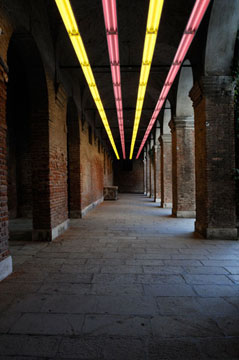
Installation shot of Bruce Nauman, "Pink and Yellow Light Corridor (Variable Lights)," 1972. Pink and yellow fluorescent lights. Solomon R. Guggenheim Museum, New York. Panza Collection, 1991. 91.3828 © 2009 Bruce Nauman / Artists Rights Society (ARS), New York. Photo credit: Michele Lamanna, courtesy Philadelphia Museum of Art.
I have never thought of myself as susceptible to patriotism, but for the second time this year, I’ve felt proud to be an American. The first incident of pride stemmed from the victory of a certain groundbreaker whose name begins with a “B” and ends with “arack Obama.” Incident number two occurred this weekend, when the United States Pavilion received the Golden Lion Award for Best National Participation in the 53rd Venice Biennale, honoring a certain artist who was featured in the inaugural season of Art:21 (2001). Ahem! Given my previous post’s shameless rhapsodizing on the bewitching beauty of Venice, you will probably not be surprised when I say that my favorite works in the Biennale are those that engage in some way with the magical surrounding city. Perhaps the committee that selected Bruce Nauman: Topological Gardens for this exciting award shared my sentiment, since the very structure of the exhibition is rooted in a rich and exciting interplay with the history, geography, architecture, and people of Venice.
Biennalers (as I have taken to calling them) have been lining up since last week outside the American Pavilion in the Giardini. Sometimes they chatted with each other, sometimes they scanned the surrounding area, but mostly they just stared straight ahead, their eyes fixed on the spiraling neon text piece that is visible through the doorway. You know the one, it’s titled The True Artist Helps the World By Revealing Mystic Truths (Window or Wall Sign). In this case, it is a window sign rather than a wall sign, hung in front of the arched glass on the far side of the Pavilion’s foyer, facing outward. This orientation means that viewers entering the pavilion read the words backwards, and only those walking outside the rear of the pavilion can read the text the “right” way. Thus the glowing pink and blue work draws viewers into the pavilion, only to suggest that they go outside of it again.
Bruce Nauman, "The True Artist Helps the World by Revealing Mystic Truths (Window or Wall Sign)," 1967. Neon, edition a/p, 59 x 55 x 2 inches, SW 99073. Private Collection. Courtesy Sperone Westwater.
Indeed, brochures, posters, banners, and even t-shirts worn by the exhibition’s security guards explicitly direct viewers to continue their experience of Bruce Nauman‘s four-decade oeuvre at two additional sites outside of the official American Pavilion. In case you consider skipping these excursions outside the Giardini, you are sure to be dissuaded from your laziness when you learn that the only new pieces of the 30-odd works in the sprawling exhibition are found in these off-site…sites. The new works, entitled Giorni and Days, are installed at the Universita Ca’Foscari, and the Universita Iuay di Venezia, respectively. Each piece is comprised of seven white panels facing each other, extending across a long corridor. The pairs of panels emanate different voices reading out days of the week, in order, over and over. As you might guess, the disembodied voices of Giordini recite the days in Italian, while Days is, yep, in English.
I have to admit, when I first learned that the American pavilion had spread Nauman’s works across three separate locations–a Biennale “first”—I was concerned that it might be an art-world version of American imperialism. Upon experiencing the diasporal exhibition, however, it became clear that these installations were, in fact, functioning in a way that destabalizes the very notion of borders, segregation, and hierarchy. Moreover, the works strive to fully integrate Nauman’s work into the exquisite context of Venice, in a way that enhances both the work and its surroundings. This is especially true for the new works, which were created specifically for this context, in collaboration with the students at the universities that house them. Not only do the rows of white rectangles visually mirror the glowing windows that line the corridor around Giorni, but the voices themselves are those of the students, and were recorded in Venice. The repetitition of the names of days not only conjures repetition in Nauman’s blinking signs and looping videos, but also the repetition of meditation. Given that the building was originally a convent, I feel that Nauman intends to reference Venice’s broader history of transition from private palaces and religious institutions to public buildings for visitors and learners. In turn, this seems to echo his own process of expanding private studio revelations to public installations.
Installation shot of Bruce Nauman, "Days," 2009. Audio (fourteen channels); continuous play; one audio source consisting of seven stereo audio files with fourteen speakers. Courtesy Sperone Westwater, New York © 2009 Bruce Nauman / Artists Rights Society (ARS), New York. Photo credit: Michele Lamanna, courtesy Philadelphia Museum of Art.
In his Art:21 segment, Nauman reveals, “I don’t generally think about large audiences. I think about, ‘who would I like to show this to?’ Who that came over to visit would I say, ‘Let me show you this…'” Whether it becomes a sign, or a projection, or a loud voice in a large space, Nauman’s work always gives the feeling that you are experiencing, in a very public way, something that is terribly intimate. In the context of the very grand Venice Biennale, this tension becomes even more exaggerated, and the work is that much more striking.